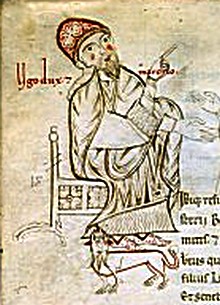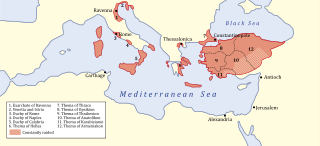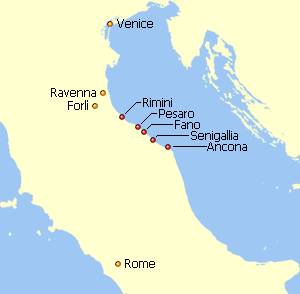Conrad I or Konrad I may refer to:

The Duchy of Spoleto was a Lombard territory founded about 570 in central Italy by the Lombard dux Faroald. Its capital was the city of Spoleto.

The Duchy of Benevento was the southernmost Lombard duchy in the Italian Peninsula that was centred on Benevento, a city in Southern Italy. Lombard dukes ruled Benevento from 571 to 1077, when it was conquered by the Normans for four years before it was given to the Pope. Being cut off from the rest of the Lombard possessions by the papal Duchy of Rome, Benevento was practically independent from the start. Only during the reigns of Grimoald and the kings from Liutprand on was the duchy closely tied to the Kingdom of the Lombards. After the fall of the kingdom in 774, the duchy became the sole Lombard territory which continued to exist as a rump state, maintaining its de facto independence for nearly 300 years, although it was divided after 849.
Alberic is a name closely related to Aubrey.
Hugh the Great (c.898–956) was Duke of the Franks.
The Duke of Spoleto was the ruler of Spoleto and most of central Italy outside the Papal States during the Early and High Middle Ages. The first dukes were appointed by the Lombard king, but they were independent in practice. The Carolingian conquerors of the Lombards continued to appoint dukes, as did their successors the Holy Roman Emperors. In the 12th century, the dukes of Spoleto were the most important imperial vassals in Italy.
Henry III, called the Younger, a member of the Luitpolding dynasty, was the first Duke of Carinthia from 976 to 978, Duke of Bavaria from 983 to 985 and again Duke of Carinthia from 985 to 989.
Alberic I was the Lombard Duke of Spoleto from between 896 and 900 until 920, 922, or thereabouts. He was also Margrave of Camerino, and the son-in-law of Theophylact I, Count of Tusculum, the most powerful man in Rome.
Transamund II was the Lombard Duke of Spoleto from 724 to 745, though he was twice driven from power by the king, Liutprand. Transamund rose to power by deposing his own father, Faroald II, and tonsuring him in a monastery.

Hugh, called the Great, was the Margrave of Tuscany from 969 until his death in 1001, and the Duke of Spoleto and Margrave of Camerino from 989 to 996. He was known for his restoration of the state apparatus in Tuscany after decades of neglect from various Margraves, whose main interests lay elsewhere. Hugh was also noted for his support of the new Ottonian dynasty, and has been praised for his justice by the contemporary theologian Peter Damian in his De principis officio. Hugh's rule has also been remembered for its close cooperation with the Papal States in the resolution of territorial disputes and his generosity in gifting marchesal (public) lands for the foundation of monasteries of the Catholic Church.

The Duchy of Rome was a state within the Byzantine Exarchate of Ravenna. Like other Byzantine states in Italy, it was ruled by an imperial functionary with the title dux. The duchy often came into conflict with the Papacy over supremacy within Rome. After the founding of the Papal States in 756, the Duchy of Rome ceased being an administrative unit and 'dukes of Rome', appointed by the popes rather than emperors, are only rarely attested.
Thrasimund I or Transamund I was the Count of Capua and then Duke of Spoleto, a faithful follower of Grimoald I of Benevento.
Welf is a Germanic first name that may refer to:

In the Byzantine Empire, the Duchy of the Pentapolis was a duchy, a territory ruled by a duke (dux) appointed by and under the Exarch of Ravenna. The Pentapolis consisted of the cities of Ancona, Fano, Pesaro, Rimini and Sinigaglia. It lay along the Adriatic coast between the rivers Marecchia and Misco immediately south of the core territory of the exarchate ruled directly by the exarch, east of the Duchy of Perugia, another Byzantine territory, and north of the Duchy of Spoleto, which was part of the Lombard Kingdom of Italy. The duchy probably extended inland as far as the Apennine Mountains, perhaps beyond, and its southernmost town was Humana (Numera) on the northern bank of the Misco. The capital of the Pentapolis was Rimini and the duke was both the civil and military authority in the duchy.
Transamund III was the Duke of Spoleto and Marquis of Camerino from 982 until his death in 989.
This page is based on this
Wikipedia article Text is available under the
CC BY-SA 4.0 license; additional terms may apply.
Images, videos and audio are available under their respective licenses.



